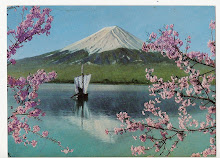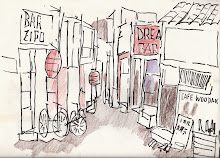THE FOLLOWING INFORMATION IS FROM THE FLICKR PHOTOSTREAM OF OKINAWA SOBA:
THE GEISHA
WHAT FOLLOWS IS SOME STRAIGHT TALK ABOUT THE GEISHA.
The life and labors of a GEISHA in old Meiji-era Japan was a far cry from the anachronistic, though still pretty and talented Geisha of the 21st Century. Way back during the Meiji-era time of these photos, she was truly an integral part of Japanese society who was called upon for numerous social activities and odd "media" realetd jobs that sometimes took her far from the "Geisha House" we usually associate her with. The Geisha were very busy girls !
First, a few words about the above photo, and then we'll get right to the REAL DEAL concerning these iconic symbols of "classic" old Japan.
THE ABOVE PHOTO is one of 260 hand-tinted, real albumen photographs tipped into the best editions of the 10-volume JAPAN -- DESCRIBED AND ILLUSTRATED BY THE JAPANESE (Published in Boston, USA in1897).
It was probably taken ca.1890-96 by K. OGAWA in his Tokyo studio.
Although there were plenty of other Geisha photos in this publication, the above image was chosen by the Japanese themselves to illustrate the only short but important statement in the book that specifically defined what a Geisha really did with her professional time. (The full statement is transcribed further below in this caption). I have amplified those comments with confirming descriptions from other sources.
I wrote the below because I was never satisfied with any other one-shot, on-line description of the Geisha's job responsibilities during those times. No doubt, my former profession as a photographer in Japan had something to to with driving me to make this statement on my photostream. I hope that something in both the content and links will be of some value to you.
*************************************
THE WORD GEISHA = GEI SHA 芸 者
[GEIKO is a Kyoto term for a GEISHA. Same thing. Six of one, Half a dozen of another]
The first character GEI 芸 is usually translated into English as Art, or the Arts.
The second character SHA 者 simply means Person.
Together they mean A person of the Arts. Therefore......ARTIST.
That's simple enough.
BUT....
SCULPTORS, PAINTERS, AND POTTERS ARE ALSO "PEOPLE OF THE ARTS".... MAY WE CALL THEM "GEISHA", AS WELL ?
NO.
The two Chinese characters for GEISHA are specifically reserved for the women in this so-named Geisha profession who have been trained from childhood in the Performing Arts such as Music, Dance, Speaking, or Singing for the purpose of entertaining others in venues clearly defined for them.
ENTERTAINERS is probably a better translation of the word, but that, too, is far from sufficient, and is more likely to conjure up images of Stand-up comedians or Lounge Singers in a Las Vegas Night Club act. Besides, there is already a general Japanese word for TV Personalities and "entertainers" in this category : 芸 能 人 GEI NOH JIN. (Notice that the first part of that word also uses the same 芸 GEI character used in GEISHA).
Actually, there is no good English equivalent for 芸 者, as the Geisha is purely a Japanese phenomena. Not even their neighbors, Korea and China came up with the exact same thing. Thus, it is simply better to use the word Geisha, and simply know what the word entails when you are talking about her.
IMPORTANT QUESTION : Returning to something already touched on above, if "Geisha" literally means "Artist" (or "A Person of the Arts"), then what words(s) do the Japanese use for other "Artists" like painters, sculptors, potters, engravers, and etc ?
EASY ANSWER : There are many other words in Japanese to describe the various artistic disciplines and art related subjects (some that use the same written character GEI 芸 of GEISHA as a part of the word or words, and others that do not include GEI). This goes for the different Japanese words used for Artists who are painters, potters, engravers, sculptors, and etc.
Even in English, we know that a RECORDING ARTIST is not the same as an artist like PICASSO or MICHELANGELO. The Japanese language is the same, and they have everybody covered with the right words and titles for whatever the heck they do.
NOTE : FOR AN IMPORTANT DEFENSE OF THE TERM "GEISHA GIRLS" AS AN ALTERNATE TO THE TERM "GEISHA", PLEASE SEE MY COMMENT APPENDED TO THE BOTTOM OF THIS CAPTION !
*****************************************************
THE TRUE-LIFE JOB DESCRIPTION OF A MEIJI-ERA GEISHA
The GEISHA (along with their MAIKO understudies) were in a class of their own.
Beautiful, talented, intelligent, and quick-witted --- they were also, on occasion, full of passion for the men that pursued them.
Although it is understood that they were NOT prostitutes, what they did in the old days (and even what they do now) has always been a little bit fuzzier in most peoples minds. The most common [and partly accurate] perception is this :
The "Geisha Girl" sings and dances the night away while pouring drinks, serving endless plates of hors d'œuvres, lighting the customers tobacco, making witty small talk, raising eyebrows and heartbeats with coy looks and innuendo, and building the egos of the male clientele --- all at drunken dinner parties held in the secluded, private "restaurants" attached to the famous Geisha Houses of the larger towns and cities.
Yes. She did do that. But in most cases, the Geisha of Japan entertained men at TEA HOUSES (Ochaya) scattered all over the open country and in urban Geisha districts. While doing this, and unless she was a free agent, she would live at an OKIYA --- a type of "boarding house" for Geisha and Maiko.
en.wikipedia.org/wiki/Okiya
But, there's more....
GEISHA WERE MODELS FOR PHOTOGRAPHERS --- Both IN and OUT of Character.
I have mentioned in some of my captions that the Geisha also served as models for the photographers, donning all sorts of garb to portray all classes of women in Japan. Some comments from flickr users expressed surprise (and doubt) that they were also "models", and wondered if that was really so.
Yes. That was really so. Please read this caption (and observe the photo) very carefully :
www.flickr.com/photos/24443965@N08/3329199977/
****Moved***** to WordPress: phillipsblogs.blog
2 months ago














No comments:
Post a Comment